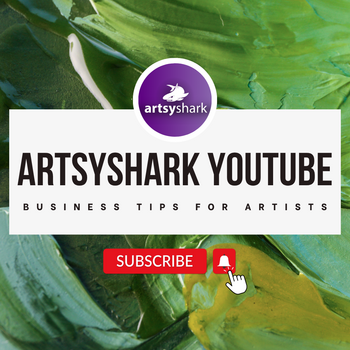by Carolyn Edlund
Email marketing is an effective way to connect with art lovers and potential customers. Here’s how to write emails that build relationships and make sales.

Every picture tells a story: Quilter Carole Lyles Shaw in her studio.
Every artist in business knows the importance of a regular marketing practice. The use of email marketing is one of the best ways to stay in touch with your fans. As you build your subscriber list, plan to reach out on an ongoing basis. Monthly email campaigns are recommended to keep your work “top of mind” with your followers. It takes multiple contacts before most sales are made, so you should make a point to follow through with consistent messaging that makes you memorable.
That said, you don’t want to be selling in every email. Most of your campaigns should serve to tell your story and share the art that you are creating, without pressure to buy. Send a “sales pitch” email only about every fourth or fifth time you contact your list. You can certainly include a link to your website or online store in all of your emails (perhaps under your signature line) as an easy way for any recipient to view more of your work whenever they like, however.
Most of your email marketing should be designed to draw people in, encourage them to feel that they know you, and share with them the art you are creating. In this way, you are working to build relationships with potential customers that are authentic and lasting, rather than constantly making a sales pitch. People are very interested in artists, how they work, and what makes them tick. Many collectors are creative people themselves, so sharing your concept, inspiration and technique with them hits the mark.
Email Topics
For your next email campaign, consider your topic. If your work is focused on a theme or a cause, that may be the perfect foundation for your emails, and you can build out a series based around that. Other potential email topics include:
- A sneak peek inside your studio, showing your creative space
- Photos of the tools and materials you use, with an explanation of your technique and why it’s interesting
- Photographs of what is inspiring your latest work
- Work-in-progress shots – what’s on the easel?
- Favorite quotes about art, or a heartfelt message that shares the passion you have for doing your work
- Shared memories from your last opening or show
- A photograph (with permission) of someone who recently bought your work – including a testimonial!
- Any news about your latest completed piece of art
- Your pet as studio mascot (with cute photos of course)
- What you’re reading now, and why you recommend it
Sales Pitch Emails
You’ve grown your list, and been in touch on a regular basis. Now you’re ready to sell. You may want to introduce a new collection, or you have new types of products available. Perhaps a holiday is coming up and your work would make the perfect gift. When writing the pitch, keep your message concise and use a straightforward Call to Action (a button is perfect for this type of email!) Consider including:
- An offer of some type of savings, such as free shipping, or a discount on framing or reproductions. (Resist reducing prices on originals or higher-end one-of-a-kind artwork. Your list may include collectors who feel they have “invested” in your art.)
- A sense of urgency. Perhaps the new collection you are introducing is small, or you are offering a limited edition. Give them a “preview” and the first chance to make a purchase before you go public with your offering. This validates their choice to become one of your subscribers.
- Time-sensitivity. When your special offering is for a limited time, they must take action. Using a coupon code with an expiration date is an effective way to do this. Place a link right next to the coupon that leads directly to the page where they can view work for sale (rather than your website Home page.)
- A focus on the benefits. The recipients of your emails signed up as “VIP” members of your audience who get first dibs, special consideration and insider offers. If you have a very special piece for sale, you might even create a special “private” landing page on your site for previews. If you are willing to take commissions, let them know how you can create something especially for them.
Why It Matters
Email communication may be sent to a lot of people on your list, but in many ways it is intimate. You as the artist are writing directly to fans who are legitimately interested in your work, and this is very meaningful to them. As your emails enter their inbox on a regular basis to share what you have in common – a love of art – you have the opportunity to build familiarity and trust with your newest collectors.
Artist credit: Carole Lyles Shaw




Such a great informative article! Thanks so much.
Best of luck on your next email campaign, Olivia!